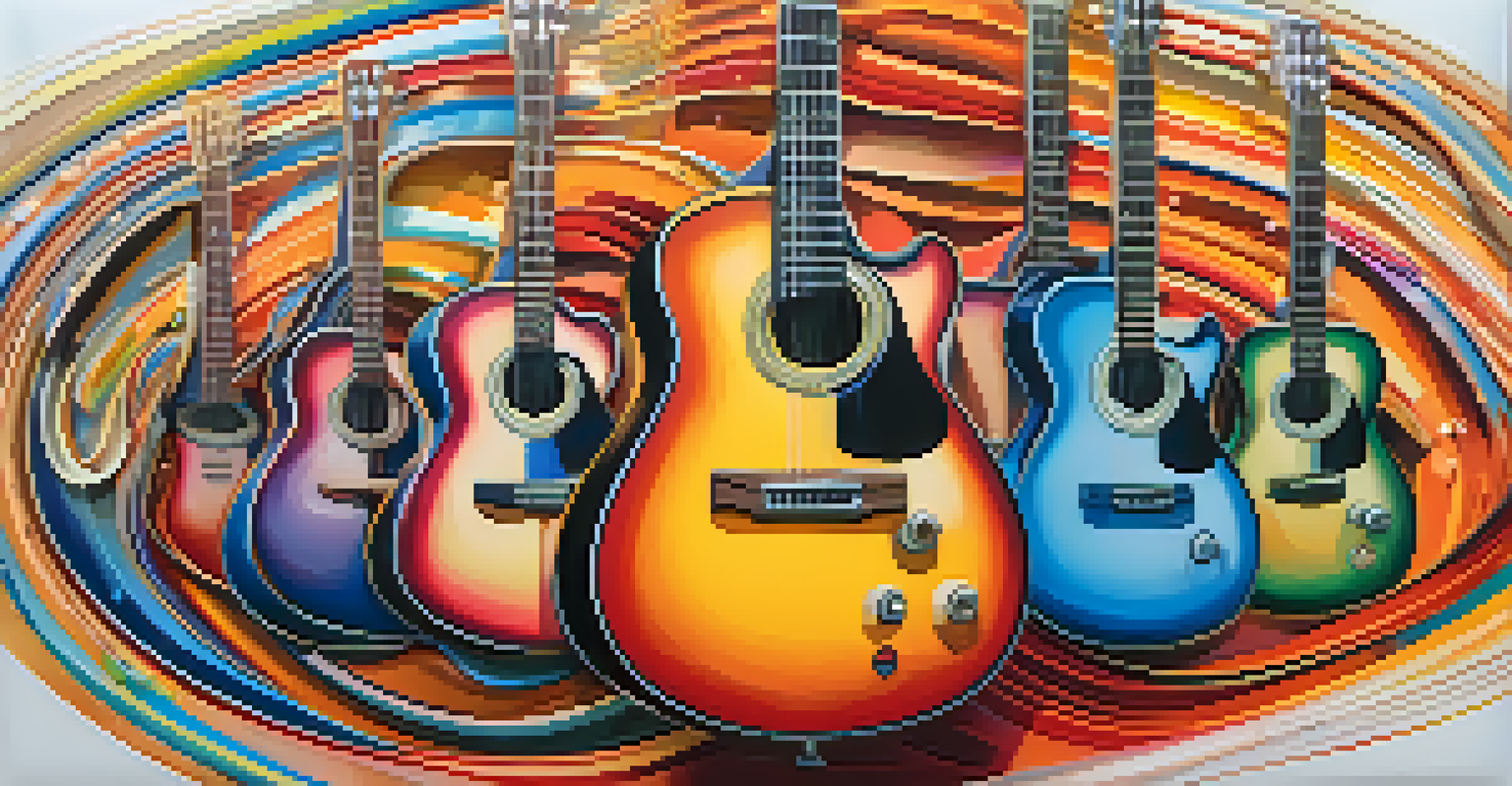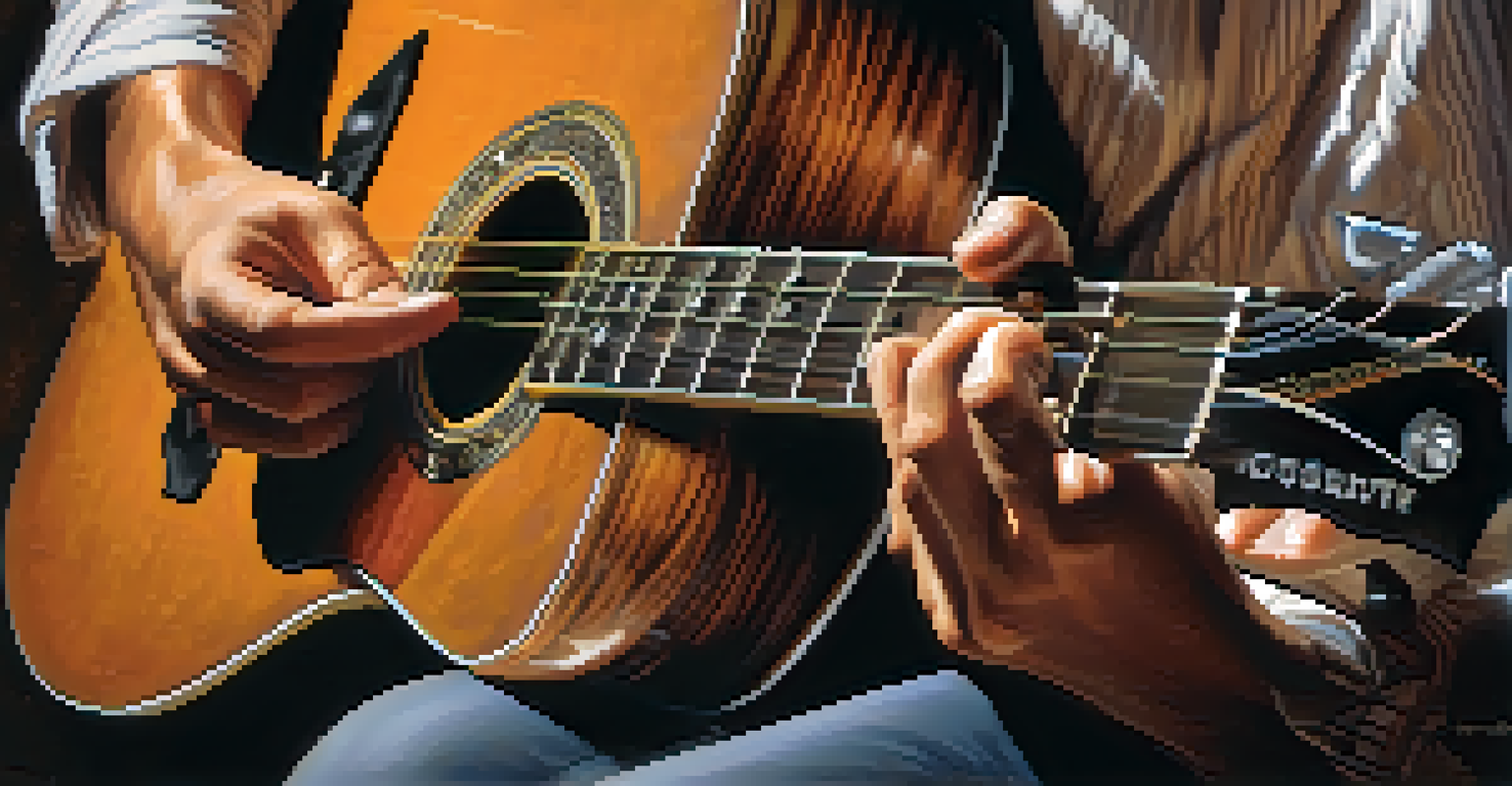Guitar Modes Explained: Unlocking New Musical Possibilities

What Are Guitar Modes? A Simple Introduction
Guitar modes are essentially scales that provide different tonal flavors. They are derived from the major scale, but each mode starts on a different note of that scale, creating unique sounds. This means that instead of sticking to the standard major or minor scales, you have a palette of seven distinct modes to explore.
Music is the shorthand of emotion.
Think of modes like different colors on an artist's palette. Just as a painter can mix colors to create new shades, guitarists can use modes to craft unique musical expressions. Each mode brings its own character; for instance, the Dorian mode has a jazzy feel, while the Phrygian mode can evoke a more exotic sound.
Understanding modes is not just about memorizing patterns; it's about enhancing your musical storytelling. When you play in a specific mode, you're not just playing notes; you’re conveying emotions and setting a mood, which can transform a simple melody into a captivating piece.
The Seven Essential Modes Explained
The seven modes are Ionian, Dorian, Phrygian, Lydian, Mixolydian, Aeolian, and Locrian. Each mode has its own unique pattern of whole and half steps, which gives it a distinct sound. For instance, the Ionian mode is just the major scale, while the Locrian mode has a darker, more dissonant quality due to its diminished fifth interval.

To make this clearer, let’s take the C major scale as an example. The notes are C, D, E, F, G, A, and B. If we start on D, we play the Dorian mode: D, E, F, G, A, B, C. You can hear how the mood shifts just by changing the starting note, demonstrating how versatile these modes can be.
Understanding Guitar Modes
Guitar modes are scales derived from the major scale, providing distinct tonal flavors that enhance musical expression.
Each mode has its own emotional resonance. The Mixolydian mode, for instance, often evokes feelings of hope and upliftment, while the Phrygian mode can create a sense of mystery. This variety allows musicians to choose the right mode to match the mood they want to express.
How to Use Modes in Your Guitar Playing
Incorporating modes into your guitar playing can be a game changer. A simple way to start is by improvising over a chord progression, using the corresponding mode for each chord. For example, if you’re playing over a Dm chord, try using the Dorian mode to capture that jazzy essence.
The beautiful thing about learning is that no one can take it away from you.
Another approach is to write melodies based on modes. Instead of starting with a chord progression, begin with a mode and build your melody around it. This can lead to unexpected and refreshing musical ideas, pushing you beyond your usual creative boundaries.
Don’t forget to listen! Explore songs that utilize different modes and try to identify them. By training your ear to recognize the sounds of various modes, you’ll not only improve your playing but also develop a deeper understanding of musical structure and creativity.
Practicing Guitar Modes Effectively
When it comes to practicing modes, consistency is key. Set aside time to focus specifically on one mode at a time, exploring its patterns and sounds. Use a metronome to develop your timing and gradually increase the tempo as you get comfortable.
Incorporate exercises that challenge you to play scales in different positions on the neck. This not only expands your fingerboard knowledge but also helps you connect modes to various chord shapes. By varying your practice routine, you'll keep the process engaging and dynamic.
Applying Modes in Playing
Incorporating modes into your guitar playing allows for creative improvisation and melody writing, enriching your musical compositions.
Additionally, consider recording yourself while practicing. Listening back can provide insights into your sound and help you identify areas for improvement. It’s a great way to track your progress and refine your understanding of how modes fit into your overall playing style.
Famous Songs That Use Guitar Modes
Many popular songs utilize modes to create their unique sounds. For instance, 'Scarborough Fair' by Simon & Garfunkel prominently features the Dorian mode, giving it a hauntingly beautiful quality. Similarly, 'Eleanor Rigby' by The Beatles employs the Aeolian mode, which adds a sense of melancholy to the melody.
Another great example is 'So What' by Miles Davis, which is built around the Dorian mode. This jazz standard showcases how modes can be effectively used in improvisation, influencing countless musicians over the years. These songs not only highlight the versatility of modes but also inspire you to explore their possibilities in your own music.
Listening to these tracks and analyzing their modes can deepen your understanding and appreciation of musical composition. As you hear how different modes contribute to the overall vibe of a song, you can start to envision how to apply these concepts to your own guitar playing.
Common Pitfalls When Learning Modes
While learning modes can be exciting, there are some common pitfalls to avoid. One major mistake is trying to learn all seven modes at once. Instead, focus on one mode at a time, mastering it before moving on to the next. This will help you internalize the sound and feel of each mode without feeling overwhelmed.
Another pitfall is neglecting to connect modes to chord progressions. Modes are most effective when used in context, so always consider the harmonic background. Playing scales in isolation can lead to a mechanical sound, whereas integrating them with chords will enrich your musical expression.
Avoiding Learning Pitfalls
Focusing on one mode at a time and connecting modes to chord progressions helps avoid overwhelm and enhances musical expression.
Lastly, don’t get discouraged if progress feels slow. Mastering modes takes time and patience. Celebrate small victories along the way, and remember that every guitarist has their own unique journey in understanding and applying modes in their music.
Unlocking Your Creativity with Guitar Modes
Ultimately, the beauty of guitar modes lies in their ability to unlock new creative avenues. By understanding and experimenting with different modes, you can move beyond the standard major and minor scales that often dominate guitar playing. This opens up a world of possibilities, allowing you to express yourself in fresh and exciting ways.
Consider setting a challenge for yourself: write a song using a specific mode and see where it takes you. This can lead to unexpected musical ideas and help break through creative blocks. By pushing the boundaries of your comfort zone, you’ll discover new sounds and enhance your overall musicianship.

Remember, music is about exploration and expression. Embrace the process of learning modes not just as a technical exercise, but as a journey toward finding your unique musical voice. With every note, you’re telling a story, and guitar modes are the tools that can help you narrate it beautifully.